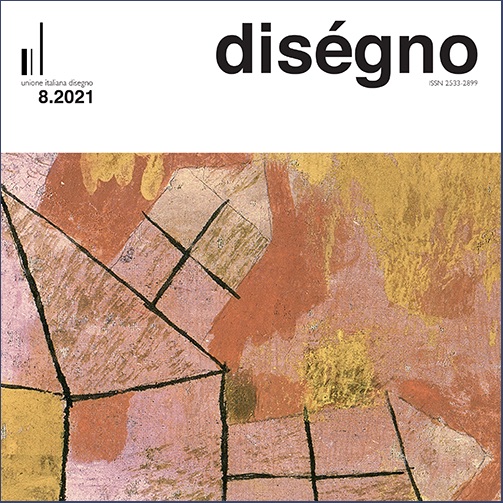Ontologia dell’intreccio. I pattern delle strutture tessili dal nodo al merletto digitale
DOI:
https://doi.org/10.26375/disegno.8.2021.7Parole chiave:
nodo, algoritmo, collegamento, tessitura, visual modelingAbstract
Uno dei fondamentali problemi tecnici progettuali riguarda la connessione delle parti componenti gli artefatti. In questo senso l’antica arte della tessitura presenta aspetti interessanti e attuali, che si applicano al campo del design e dell’architettura e rimarcano la verità delle affermazioni di Gottfried Semper riguardo la classificazione di materiali e tecniche costruttive. Il connubio tra tecnologia digitale e pattern della tessitura, derivazione dello sviluppo della struttura del nodo/bottone nell’intreccio e poi nel merletto, permette di realizzare strutture tessili applicabili in molteplici settori e dotate di proprietà prestazionali ed estetiche derivate dagli archetipi formali propri della costruzione del tessuto. Fin dall’invenzione nel XVII secolo del telaio Jacquard, l’innovazione tecnologica ha dato notevole impulso al settore tessile. Partendo dalla tradizione cinquecentesca del merletto a fuselli milanese, passando per le interpretazioni novecentesche nell’ambito delle scuole legate al Movimento Moderno e arrivando alle interpretazioni odierne, la ricerca ha l’obiettivo di sperimentare l’applicazione di strutture generate da algoritmi digitali per la produzione dei manufatti e per la valorizzazione di un patrimonio di saperi. Definiti gli elementi di base, i movimenti d’intreccio e il ciclo completo da ripetere nella tradizione del merletto, è possibile ricreare la struttura formale mediante il controllo geometrico dei parametri di forma e movimento.
Riferimenti bibliografici
Guglielmetti, I. (2015). Cultural Design: un tentativo interdisciplinare sperimentato nel progetto. Design al tombolo. In Antropologia, vol. 2, N° 2, pp. 141-156.
Il girovago (1943). La scuola di Cantù. In Fili, n. 113, maggio 1943, pp. 2-7.
Jourdain, M. (1905). The Lace Collection of Mr. Arthur Blackborne. Part IV - Milanese Laces. In The Burlington Magazine for Connoisseurs, vol. 6, No. 23, February 1905, pp. 384, 385, 388-391, 393.
Ponti, G. (1939). Per l’affermazione delle industrie femminili italiane. In Domus, n° 139, luglio 1939, pp. 65, 66.
Read P., Kindcaid L. (1988). Milanese Lace. An introduction. London: Batsford.
Read P., Kindcaid L. (1994). New Braids and Designs in Milanese Lace. London: Batsford.
Semper, G. (1860). Der Stil in der technischen und tektonischen Künsten oder, Praktische Ästhetik. Ein Handbuch für Techniker, Künstler und Kunstfreunde. Band 1: Die textile Kunst für sich betrachtet und in Beziehung zur Baukunst. Frankfurt a.M: Verlag fur Kunst und Wissenschaft [Trad it. parziale in Lo stile nelle arti tecniche e tettoniche o estetica pratica. Bari: Laterza, 1992].
Yi, L. (2007), Computational Textile Bioengineering. In Xianyi Zeng et al. (eds.) Computational Textile. Berlino: Springer, pp. 203-221.
##submission.downloads##
Pubblicato
Come citare
Fascicolo
Sezione
Licenza
Copyright (c) 2021 diségno

TQuesto lavoro è fornito con la licenza Creative Commons Attribuzione 4.0 Internazionale.






